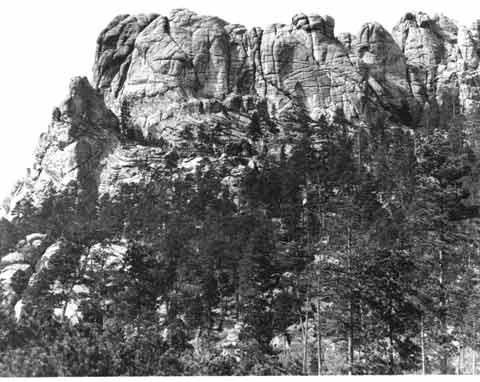The nearly 400 units of our National Park System include the names of some famous men and women, along with those of natural features and historical events, but the origin one of those monikers is a bit more obscure.
During a visit to Mount Rushmore National Memorial last summer, I overheard one of those classic tourist questions. A visitor walked onto the plaza behind the visitor center, gazed intently at the stone faces, and then turned to a park ranger standing nearby.
"So, which one is President Rushmore?"
Although the question may arouse despair among some educators and historians, it does give rise to an interesting inquiry. What notable achievement by someone named Rushmore resulted in the attachment of his or her name to an impressive natural feature? Was he a South Dakota pioneer, or a lesser-known military or political figure?
According to the park's website,
Mount Rushmore is named after a New York City attorney. Charles E. Rushmore was sent out to this area in 1884 to check legal titles on properties. On his way back to Pine Camp he asked Bill Challis [a local resident and guide] the name of this mountain. Bill replied, "Never had a name but from now on we'll call it Rushmore."
An interesting event, but other mountains around the world have probably acquired their names through serendipitous circumstances. I doubt that either of these men anticipated in 1884 that Mount Rushmore would eventually become a major tourist destination.
Four decades passed before a plan to attract more visitors to the Black Hills began to develop, but the original concept had nothing to do with presidents—or Mount Rushmore.
In 1923, South Dakota state historian Doane Robinson conceived the idea of a group of colossal carvings of western heroes such as John Fremont, Lewis & Clark, Sacagawea, and Buffalo Bill Cody. The goal was to "attract more people to the Black Hills of South Dakota," and the proposed location was not Mount Rushmore, but a nearby area known as the Needles.
Sculptor Gutzon Borglum came to South Dakota in 1924 to survey the area for a suitable site for the carving. A park publication notes,
When Borglum inspected the Needles, he found them to be too thin and weathered to support sculpture on a grand scale. Borglum and the other carving supporters needed to find a new place to carve or abandon the project. It was then they were told about Mount Rushmore. When Borglum saw the mountain he pointed to it and said, "America will march along that skyline."
According to information from the American Folk Life Center at the Library of Congress,
Borglum was opposed to the idea of carving western figures, saying that it should be "a national monument commemorating America's founders and builders"... It was decided that the individuals who best exemplified the foundation, expansion and preservation of the Republic—Washington, Jefferson, Lincoln and Theodore Roosevelt—should be the subjects of the memorial.
Anyone who visits the park expecting to find the face of President Rushmore will be disappointed, but I think it's safe to say that Charles E. Rushmore was proud of the transformation of the mountain that bears his name. He was reportedly one of the major donors for Borglum's project, and Rushmore's experience confirms that sometimes the key to fame is simply being in the right place at the right time.




Comments
My grandfather was from Brooklyn and his name was Elbert Rushmore. I have been trying to find out if the Rushmore Family has an extended family tree on Ancestry. Would love to find out if we are related. We think we probably are as our family has very long roots in New York.
woykd love to her from you!